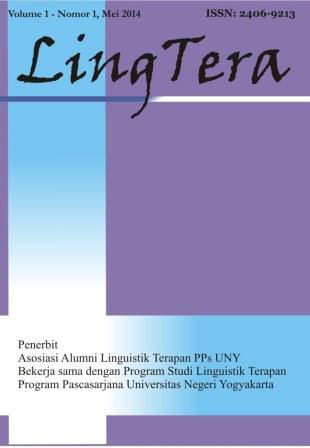Assessing undergraduate students' level of independent learning as a manifestation of learner autonomy
DOI:
https://doi.org/10.21831/lt.v10i1.59870Keywords:
independent learning, learner autonomy, undergraduate studentsAbstract
References
Allan, B. (2010). Study skills handbook (seventh edition). Hull University Business School.
Benson, P., & Voller, P. (1997). Autonomy and independence in language learning. Longman.
Benson, P. (2011). Teaching and researching autonomy (2nd ed.). Pearson Education.
Benson, P., & Reinders, H. (2011). Beyond the Language classroom. Palgrave Macmillan.
Candy, C. (1911). Self-direction for lifelong learning. Jossey-Bass.
Carnell, B. (2015). Aiming for autonomy: Formative peer assessment in a final-year undergraduate course. Assessment & Evaluation in Higher Education, 41(8), 1269-1283, http://dx.doi.org/10.1080/02602938.2015.1077196.
Cavana, M. (2011). Autonomy and self-assessment of individual learning styles using the European Language Portfolio (ELP). Cercles, 1(1), 211-228. http://dx.doi.org/10.1515/cercles-2011-0014.
Cotterall, S. (1995). Readiness for autonomy: Investigating learner beliefs. System, 23(2), 195–205. https://doi.org/10.1016/0346-251X(95)00008-8.
Dam, L. (1990). Developing awareness of learning in an autonomous language learning context. In R. Duda & P. Riley (Eds.), Learning styles (pp. 189-97). Presses Universitaires de Nancy
Deci, E., & Ryan, M. (1985). The general causality orientations scale: Self-determination in personality. Journal of Research in Personality, 19(2), 109–134. https://doi.org/10.1016/0092-6566(85)90023-6.
Dixon, D. (2011). Measuring language learner autonomy in tertiary-level learner of English, (PhD), University of Warwick.
Guglielmino, L. (1977). Development of the self-directed learning readiness scale, (PhD). University of Georgia.
Holec, H. (1981). Autonomy and foreign language learning. Oxford: Pergamon.
Hughes, P. (2003). Autonomous learning zones. Paper presented in European Conference for Research on Learning and Instruction, Padova, Italy.
Joshi, K. (2011). Learner perceptions and teacher beliefs about learner autonomy in language learning. Journal of NELTA, 16(1), 13-29. 10.3126/nelta.v16i1-2.6126.
Knowles, M. (1975). Self-directed learning: A guide for learners and teachers. Association Press.
Kumaravadivelu, B. (2003). Beyond methods: Macrostrategies for language teaching. Yale University Press.
Lin, L., & Reinders, H. (2017). Assessing learner autonomy: Development and validation of a localized scale. New Language Learning and Teaching Environments, 307-328. DOI 10.1057/978-1-137-60092-9_14.
Little, D. (1991). Learner autonomy: Definitions, issues, problems. Authentic.
Littlewood, W. (1996). Autonomy: an anatomy and a framework. System, 24 (4), 427-435. https://doi.org/10.1016/S0346-251X(96)00039-5
Mardjuki, S. (2018). Learner autonomy: Gender-based perception among EFL Indonesian students. Indonesian Journal of EFL and Linguistics, 3(1), 1-17. https://doi.org/10.21462/ijefll.v3i1.46
Mesiridze, I., & Tvaltchrelidze, N. (2017). Promoting autonomous learning through self-, peer-, and co-assessment to ensure high quality in Georgian higher education (a case study of International Black Sea University, Georgia). Journal of Education in Black Sea Region, 2(1), 69-81. DOI:10.31578/jebs.v2i2.43
Murase, F. (2015). Measuring language learner autonomy: Problems and possibilities. In C. J. Everrhard & L. Murphy (Eds.), Assessment and autonomy in language learning (pp. 35–63). New York: Palgrave.
Najeeb, S. (2012). Learner autonomy in language learning. Social and Behavioral Sciences, 70, 1238-1242. doi: 10.1016/j.sbspro.2013.01.183
Nematipour, M. (2012). A study of Iranian EFL learners' autonomy level and its relationship with learning style. English Linguistics Research, 1(1), 126-136. DOI: https://doi.org/10.5430/elr.v1n1p126
Oddi, L. (1986). Development and validation of an instrument to identify self-directed continuing learners. Adult Education Quarterly, 36(2), 97–107. DOI:10.1177/0001848186036002004
Puspasari, A., Hudayani, N. (2018). Increasing autonomous learning through peer assessment technique. Proceeding of the 1st Annual International Conference on Language and Literature, 18-19 April 2018.
Razeq, A. (2014). University EFL learners' perceptions of their autonomous learning responsibilities and abilities. RELC Journal, 45(3), 321-336. https://doi.org/10.1177/0033688214547
Ridley, J. (2003). Learners' ability to reflect on language and on their learning. In David Little, Jennifer Ridley & Ema Ushioda (eds.), Learner autonomy in the foreign language.
Thanasoulas, D. (2000). What is learner autonomy & how can it be fostered. The Internet TESL Journal, VI(11).
Wenden, A., & Joan, R., (eds.). (1987). Learner strategies in language learning. Prentice Hall International.
Zhou, R. (2017). A multi level formative assessment of autonomous college English learning based on analytic hierarchy process. International Conference on modern Education and Information Technology, 2017.
Downloads
Published
How to Cite
Issue
Section
Citation Check
License
LingTera allows readers to read, download, copy, distribute, print, search, or link to its articles' full texts and allows readers to use them for any other lawful purpose. The journal allows the author(s) to hold the copyright without restrictions. Finally, the journal allows the author(s) to retain publishing rights without restrictions.
- Authors are allowed to archive their submitted articles in an open-access repository.
- Authors are allowed to archive the final published article in an open-access repository with an acknowledgment of its initial publication in this journal.

Psychology, Evaluation, and Technology in Educational Research is licensed under a Creative Commons Attribution-ShareAlike 4.0 International License.
Based on a work at https://petier.org/index.php/PETIER.









